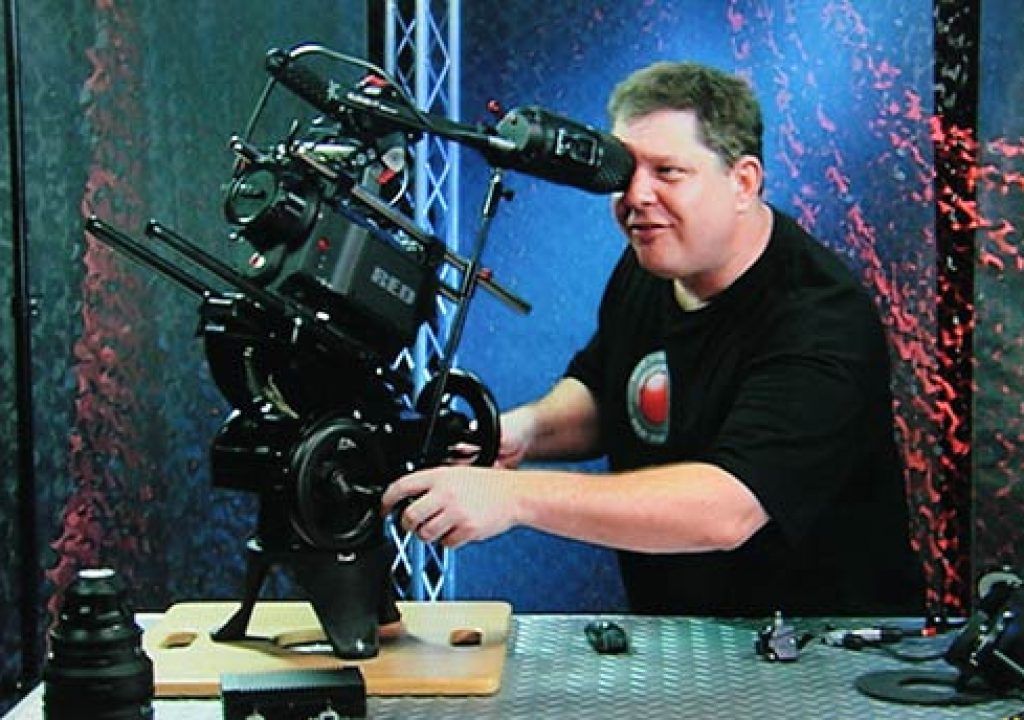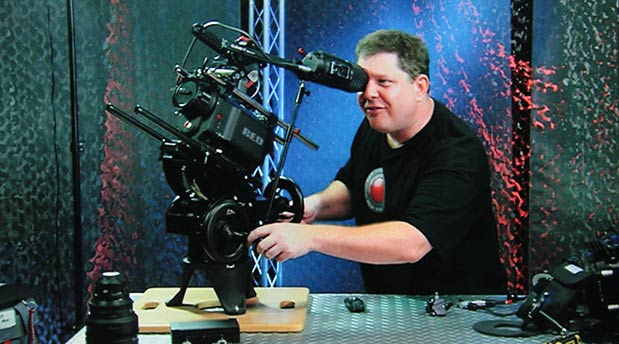
Jay Kelley describes using the RED ONE on a gearhead with an eyepiece leveler.
RED101 is a $60 DVD set covering most of what you need to know to build, configure, and operate a RED ONE camera. If you’re thinking about buying or renting a RED ONE, or you just want to know your way around the camera, RED101 is a quick, easy, and enjoyable way to learn the basics.
Jay Kelley is a shooter and director with 20 years of industry experience, and owner of DreamWelder Productions in St. Louis, MO. Mr. Kelley owns RED ONE #327, and he is both the creator of this two-DVD training program and the on-screen presenter of the material.
All screenshots are photographed off my computer monitor; any errors of cropping, color balance, and tonal scale are mine alone.
The images themselves are copyright © 2009 by Jay A. Kelley, DreamWelder Productions.
What It Is
Disc One is structured as a series of short clips between three and twenty minutes in length, covering the general theory of operation, basics of the camera’s physical layout and menu structure, how to build the camera for a variety of uses, and a variety of accessories and support items:
- Intro to DVD: Mr. Kelley describes how the DVD works, what the various graphic overlays mean, and the ways you can navigate the material.
- Camera Basics: Introductions to the RED ONE camera and how it works; an overview of the camera body and controls; and a quick walkthrough of the camera’s displays, menus, and setup for shooting.
- Setups – Camera Builds: Examples of building the camera for use on Steadicams and jib arms; for handheld use; for working on tripods; for use on a dolly. There’s also an overview of the “Hybrid Build”, or configuring the camera ENG-style for fast, lightweight, single-operator uses.
- Setups – Software Builds: A detailed, step-by-step menu walkthrough to set the camera up for standard, 4K 24fps shooting, plus the changes needed from the standard setup to shoot 3K 48fps and 2K 96fps. The DVD includes a STARTUP.PDF menu guide with these steps highlighted.
- Procedures: Tapeless workflow as applied to RED; a heads-up on the RED ONE’s infrared sensitivity when using heavy ND filters; a quick overview of post options; how to clean the sensor and adjust back-focus.
- Accessories: Intros to Anton-Bauer batteries and chargers; Arri matte boxes and wireless lens controls; Cool Lights lighting instruments; DSC Labs test charts; Leader’s LV-7330 rasterizing WFM/vectorscope; the Gearnex gearhead; Formatt filters.
- Renter’s Section: A nicely-structured intro and menu system designed to get you the most critical need-to-know info as quickly and painlessly as possible—ideal for panicky last-minute viewing the night before going out on a RED gig.
Disc Two is a detailed walkthrough of all the menus in RED build 21 firmware, organized neatly in the same order as the menu buttons on the camera itself:
- Sensor Menu Button, covering the Sensor menu;
- Video Menu Button, describing the Video button’s menus;
- System Menu Button, no prizes for guessing what this covers;
- End Credits / Bloopers, listing the folks responsible, and emphasizing that small children are not sold as part of the RED101 DVD set.
The discs open with a high-tech, heavy-metal graphic intro, and the menus, graphics, and production design continue this theme, with lots of visual eye candy and positively pornographic closeups of the equipment.
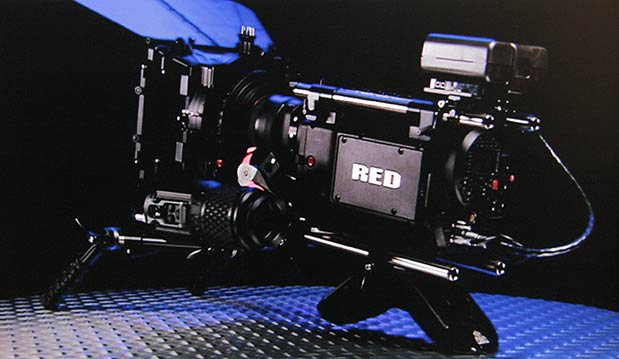
Oh, yeah. Camera porn, plain and simple.
Jay Kelley, by contrast, is a friendly, folksy host with a ready smile and an easy manner. He presents his material smoothly and efficiently, pacing his delivery like any good teacher does: quickly enough that you don’t get bored or antsy, yet slow enough that you can absorb the material. Frequent cutaways to closeups of connectors, accessories, screen displays, and menus complement Mr. Kelley’s conversational delivery. The overall effect is much like going out on several gigs with him and watching as he sets up the camera and configures it for different shooting styles, while he describes what he’s doing and drops useful hints and tips along the way.
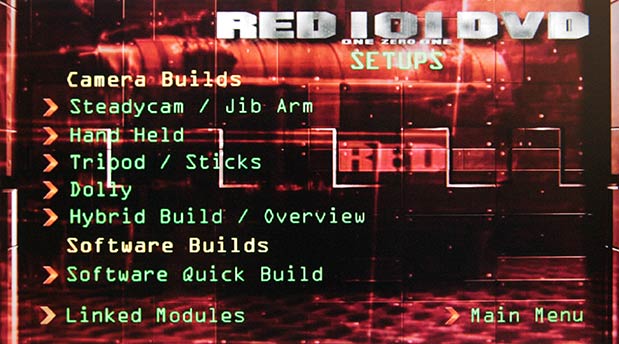
The SETUPS submenu lets you easily focus on the stuff you need.
His five camera setups—Steadicam / jib arm, handheld, tripod, dolly, and hybrid—give him the opportunity to demonstrate a variety of accessories suited to each mode of operation: Arri matte boxes, the Gearnex gearhead, Arri’s wireless lens controls, Element Technica’s Mantis handheld rig, EVF mount, and EVF leveling system, Birger Engineering’s lens mount for Canon EF lenses, ASL’s side-panel breakout box, and more.
RED101 makes good use of DVD’s random-access capabilities. At many points during a demo, the DVD offers an “info” link for more details on a procedure or a bit of gear under discussion: how to adjust back-focus, what matte boxes are available, etc. You can select the info link for a short clip about the topic at hand, after which you’re returned to the program you lined from. All the linked topics are also available separately, through the top-level menus, too. The “Renter’s Section” menu combines a info-linked introduction with a submenu of relevant topics so that you can get up to speed with the basics of RED in a streamlined manner without having to search through the entire DVD to answer a pressing question.
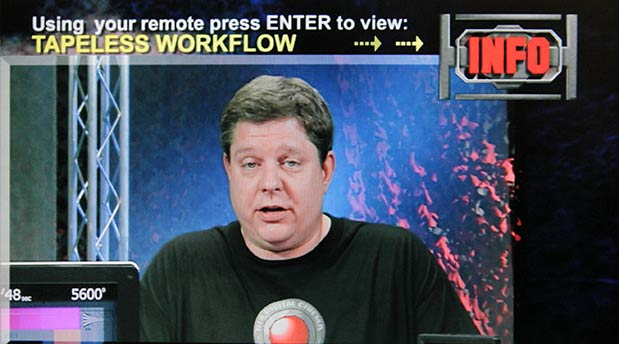
When another segment covers a topic in more detail, you can jump to it.
Throughout the demonstrations, Mr. Kelley is careful to point out that his configurations and setups are suggestions, not requirements; there are many valid ways to set up a RED ONE, and his ways work for him but may not work for you. I found this very helpful; it’s easy to watch a presentation of this sort and come away with the feeling that This Is The Way It Must Be Done. Mr. Kelley’s frequent reminders that things can be done differently is a refreshingly realistic approach, one that acknowledges the variables present in real-world production.
He also talks about practical consideration, and offers up some nice tricks, like counterbalancing a gearhead-mounted camera using heavy accessories on rearward-extended top rods instead of sliding the camera backwards (so that you can tilt up without having the base of the camera run into the tilt wheel), and how to make your own matte box donuts (hint: mouse pads). I learned several things I never knew, like what the silver screws on the side of the MB20’s filter tray holders actually do, and that the Element Technica EVF mount can be attached directly to the Mantis rig.
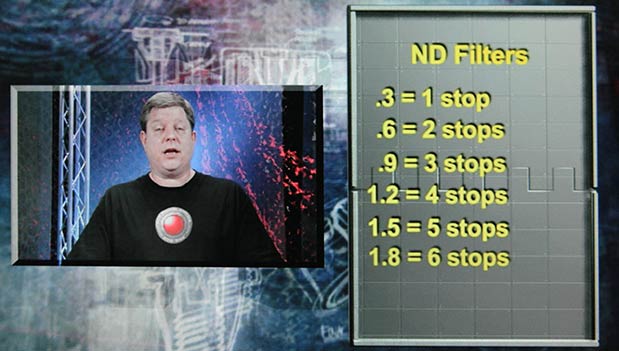
Text boxes help keep things straight, and aid searching through segments for specifics.
The section on hybrid builds is worth the price of the DVD: it’s a reminder than you don’t need to build the camera up with follow-focuses, matte boxes, etc.; you can travel light (all things being relative, of course) and work with compact still camera lenses, pulling your own focus through the lens ENG-style.
There are good discussions of tapeless workflows, including backup strategies and schedules; IR contamination; and a (somewhat dated) overview of post workflow options, with the valuable inclusion of Cineform’s codec as an editing option.
An “Epic & Scarlet Future Proof” bug pops up to let you know when a bit of gear will work with future cameras as well as RED ONE.
The Quickstart Guide on disk one is the Octamas menu guide with the necessary options for a variety of shooting setups highlighted. While the Quickstart Guide is based on build 20 beta, it’s still a handy reference; the critical parts of these setups haven’t changed a lot in the current builds aside from color-space and gamma selections.
What It Isn’t
It’s not an encyclopedic reference to all the possible ways a RED ONE can be set up and configured, and it doesn’t list all the possible accessories and add-ons you can build out a RED kit with. It’s “RED101”, after all, not “RED Four-Year Degree Program”.
Sometimes the casual style of the presentation omits useful information, like the difference between linear and circular polarizers: he mentions both, but doesn’t say anything more about them. One clip shows off three different Arri matte boxes without a good description of the tradeoffs between them. When Mr Kelley talks about using the DSC Labs CDM chart to tweak color, he neglects to mention that you first need to boost vectorscope gain to put the red dot in its target box. But these are omissions that only a pedant like me would object to; this is an intro to RED, after all, not a comprehensive tutorial on all aspects of digital video, cinematography and engineering.
The Accessories sections verge on product pitches, with some marketing hype intruding, but they’re still useful overviews of some of the tools available. Mr. Kelley admits that he had some vendor support in making the DVD, which may explain some of the suspiciously enthusiastic verbiage; still, he says that everything he shows off is stuff he himself uses, believes in, and swears by.
There are a few typos in the onscreen text; one of the info links jumps back to the wrong place in the main presentation; a couple of the segments return to the menu in mid-sentence, just a few seconds too early; and some of the visuals aren’t quite as explanatory as they could be. None of these is misleading or confusing (with the possible misspelling of “Origo” as “Orego”, which will definitely frustrate anyone doing a web search on the term [Origo is Viewfactor’s remote start/stop button]).
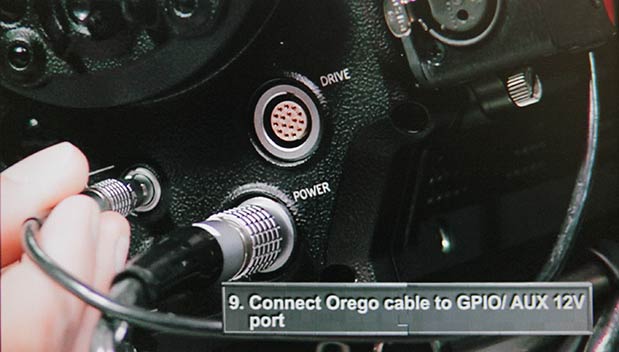
Close-ups make the important info stand out, despite the occasional typo.
Overall, there are only a few things I can really whine about with this DVD set, and they’re more warnings than complaints.
First, the coverage of accessories is a bit too narrow in that alternatives are never described. We get a good look at Arri’s wireless lens control system, but Preston, Heden, and Cmotion aren’t even mentioned, and Viewfactor’s Impero is only shown as a controller for the Birger EF lens mount. There’s a detailed (and very useful) section on Anton-Bauer batteries, but RED’s own batteries, charger, and AC adaptor don’t exist as far as RED101 is concerned.
Just be aware that there are a lot of options that RED101 doesn’t describe.
Second, RED101 covers RED firmware Build 21, but most cameras have moved on since this DVD was created (as I write this, Build 30 is current). 90% of the system settings and menu options remain the same, but some of the onscreen displays have been updated, more options exist in the menus, and the color-space and gamma settings in Build 30 differ from prior versions. RED101 will get you 90% of the way through the current menus, but you’ll still need to peruse the RED documentation and the Octamas menu guides to get current on everything.
Mr. Kelley doesn’t plan to re-release RED101 with updates, but he is developing a similar DVD set for the Epic and Scarlet cameras, covering Build 30, and he expects he’ll have some sort of reduced-price deal for purchasers of the RED101 DVD set.
Third, Mr. Kelley doesn’t really make it clear that the basic RED ONE camera is a naked body; you have to add on top mounts, a bridge plate, and (optionally) a cheese plate before you can attach anything else to the camera—even a carrying handle.
Finally, Mr. Kelley recommends the O’Connor 1030 fluid head. I find that most of my RED configurations are heavier than I’d want on a 1030; we use the heftier 2060s, and even then, we have the counterbalance settings up between 65% and 99% most of the time—and sometimes I wonder if we shouldn’t have a 2575 in our kit as well. Mr. Kelley also builds up a top handle attached to the camera only at the front of the body; he says it’s fine, but I don’t feel comfortable unless I use the extension as well, affording a more secure four-screw attachment to the heavy camera than the two-screw attachment of the top handle alone.
Yes, it comes down to that: if I have to have a substantive disagreement with anything on the RED101 DVD set, it’s on the topic of how hefty the fluid head and the top handle should be.
Conclusion
The RED101 DVD set is the best single source I’ve seen for getting an introduction to the RED ONE camera, its general theory of operation, its menus, and the various ways it can be built up to perform a variety of missions. RED101 is a valuable starting point for anyone new to RED, and even experienced operators may learn a thing or two.
It doesn’t replace the manual, but it’s a much more graphic and user-friendly way to learn how the menus are laid out and to get into the right mindset to work with the RED’s system interface. It’s especially useful for those coming from smaller, more traditional video cameras: RED101 clearly demonstrates a variety of ways to build the camera for cine-style configurations.
RED101 will save you hours of time you’d otherwise have to spend wading though the noise of reduser.net and observing on RED shoots to get the same level of familiarity with the camera. I’m not saying that those other activities aren’t valuable as well, but I am saying that you’ll get more information in a shorter time by studying RED101 first, and using it as your launching point for a deeper exploration of the camera.
If it had been around when I was starting to learn RED, RED101 would have accelerated my learning curve considerably. If you’re thinking about buying a RED ONE, renting one, or assisting on a RED shoot, spending an evening with RED101 is a great way to prepare for the experience.
Pros
- RED101 covers all the basics of configuring and building the RED ONE camera.
- Great way to get familiar with the RED ONE’s menus and firmware options.
- Friendly, well-paced instructional style.
- Good production values with plenty of eye candy.
- Well structured DVD organization, allowing direct access to items of interest.
- Very reasonably priced.
Cons
- Only covers Build 21; no discussion of Build 30 options or the M-X sensor.
- A few typos and technical glitches.
- Occasionally a menu option or an accessory isn’t described as fully as I’d like.
- Accessory reviews are a bit heavy on the marketing hype.
- Mention of alternative accessories is lacking.
16 CFR Part 255 Disclosure
Jay Kelley contacted me and asked me to review the RED101 DVD set, and I agreed; before he wrote me, I didn’t know anything about Mr. Kelley or RED101. He sent me the DVDs for review.
After viewing them and outlining this review, I wrote Mr. Kelley back and asked how he wanted the DVDs returned. He said he didn’t want either of us paying for return postage: “Do with it what you wish.” I will give it to the DCS for a raffle prize (I’m on the advisory board for the DCS, so it’s the least I can do).
I have been working with RED ONE cameras since 2008 and Build 16; the studio I work for bought three on my recommendation.
Aside from that, there is no material connection between myself and Jay Kelley or RED, and I have received no compensation to encourage a favorable review.

Filmtools
Filmmakers go-to destination for pre-production, production & post production equipment!
Shop Now